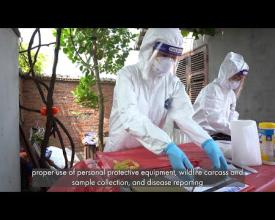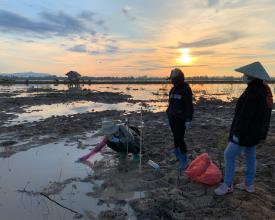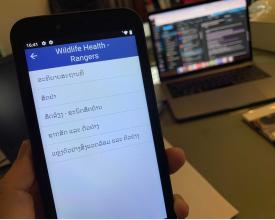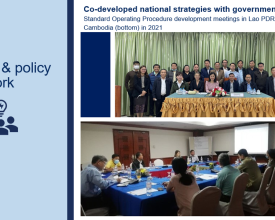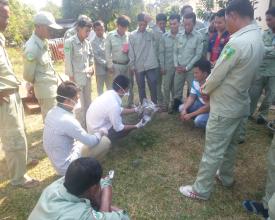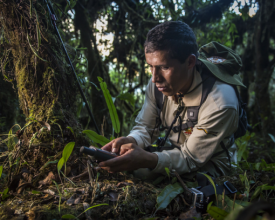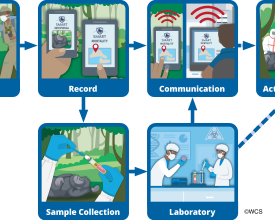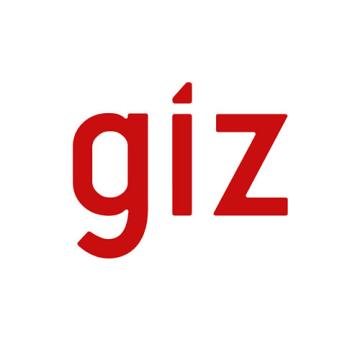
WildHealthNet Southeast Asia: Operationalizing Wildlife Health Surveillance for One Health
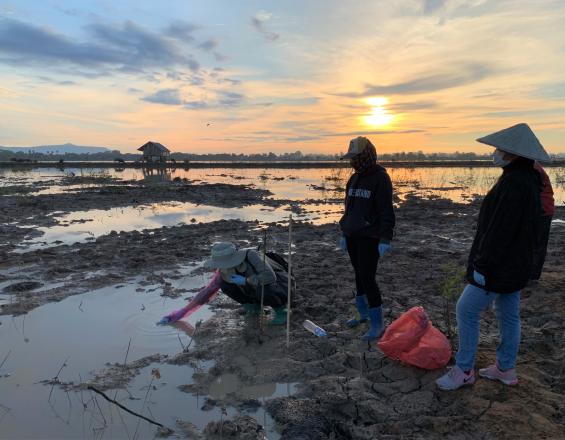
The Wildlife Health Surveillance Network, known as WildHealthNet, is a regional initiative supporting national governments in Cambodia, Lao PDR, and Viet Nam to build and implement national wildlife health surveillance strategies. The project has enhanced the ability of these nations to safely detect, monitor, trace, and report emerging pathogens in wildlife, to facilitate more rapid response and mitigation. The system has already detected trans-national disease outbreaks of zoonotic diseases and pathogens of economic, wildlife, and human health significance. More rapid identification of wildlife pathogens benefits public health, livestock health, rural livelihoods and food security, and conservation.
Context
Challenges addressed
Human encroachment into natural areas, climate change, and the commercial wildlife trade, bring people, wildlife, and livestock into closer and more frequent contact, increasing the “spillover” risk of zoonotic-origin diseases like Covid-19, Ebola, HIV, and SARs. Over 70% of emerging zoonotic diseases originate from wildlife. Despite the relevance of wildlife pathogens for biodiversity, livestock, and humans, established wildlife health surveillance programs remain rare. A 2021 review found almost 60% of reporting countries had no evidence of functional wildlife surveillance. WildHealthNet supports government partners to develop wildlife surveillance programs that integrate with existing national surveillance and One Health platforms. The approach connects people who encounter wildlife, including rangers, hunters, and animal rescue centers, with stakeholders who can take action to analyze disease threats and try to prevent their spread.
Location
Process
Summary of the process
The first three building blocks are the foundations that support the fourth building block: an effective multisectoral One Health response. Building networks and national strategies that define roles and processes; bridging capacity for each of the specific stakeholders; and introducing appropriate open technologies to support reporting and data management and sharing together enable the translation of data into actions that can protect wildlife, human, and animal health and well-being.
Building Blocks
Multi-sectoral network building for monitoring wildlife diseases for One Health
- WildHealthBuild: Building partnerships and breaking down silos across the human health, animal health, and environment/ wildlife sectors is an essential first step in planning and implementing wildlife surveillance for One Health intelligence, improving coordinated result sharing and response and the likelihood that networks and sustainable and used to guide science-based policy and disease control mechanisms going forward.
Enabling factors
- Long-term funding from international donors
- Support and buy-in from national government actors at local, provincial, and national levels
- Support and buy-in from central government across human health, animal health, and wildlife/ environmental sectors
Lesson learned
Convening regular multi-sectoral meetings for open discourse on the challenges and opportunities to monitoring and management of disease at the wildlife-human-livestock interface, and improving communications and trust between and across sectors, is critical in the joint development of functional, long-term wildlife surveillance networks for One Health intelligence, and adoption of associated policies. This takes considerable time and a sustained effort, often, unfortunately, outside of the normal funding cycles of donor agencies.
Supporting Skills Development for Surveillance and Monitoring of Wildlife Disease
WildHealthSkills: WildHealthNet conducts capacity bridging and building with in-person and virtual trainings for all actors in the network, from field-based rangers to laboratory techs to national coordinators. The goal is to develop and share science-based protocols and best practices, and implement strong curricula so that each actor is empowered to fully participate.
Enabling factors
- Long term financial support for technical expertise and input
- Government and local stakeholder awareness of the links between wildlife health and human health and well-being
- Government and local stakeholder interest and engagement in capacity development for wildlife surveillance and wildlife health monitoring
- Adequate human personnel without too much turnover, in order to maintain network
Lesson learned
A foundational understanding of the links between wildlife/ environmental health and human and domestic animal health and well-being ensures better interest and buy-in for One Health competency training such as wildlife surveillance. Stakeholder-specific trainings (e.g. Event detection and reporting for forest rangers; Necropsy and pathology for laboratory staff/ veterinarians; Sample collection and handling for rangers & confiscation teams; Technology for network coordinator and rangers), multi-lingual training packages, with core competencies and evaluation tools enable broader reach and buy-in for capacity building and maintenance and continued expansion of the surveillance network national, regionally and globally.
Technology for Wildlife Surveillance Data Collection, Sharing and Management
WildHealthTech: WildHealthNet develops and employs innovative, appropriate, and user-friendly technologies for surveillance. With proven, globally distributed, open-source software (e.g., SMART for Health) and hardware like handheld cell phone devices for data collection and diagnostics, WildHealthNet supports effective and timely communication of data for improved reporting of wildlife health and rapid response.
Enabling factors
- Cell-phone network accessibility and cell phone provision
- Human personnel to monitor network and data at the central level
- Access to a server
- Diagnostic capacity for safely testing wildlife samples for pathogens of concern (Point-of-care for some pathogens; in-country laboratories; regional laboratory networks, and agreements to support rapid and biosecure export, testing, and data sharing)
- Technical and analytical support
- Financing to enable technical support and capacity development for data platforms and data analysis
Lesson learned
- Early detection of wildlife morbidity and mortality events facilitates a timely and appropriate response to disease threats; the inability to detect and identify the causes of mortality events is a major limitation in the protection of wildlife, livestock, and public health.
- Employing an already proven open-source and cell-phone-based technology through the Spatial Monitoring and Reporting Tool (SMART) platform used by rangers in close to 1,000 biodiverse sites across the world, leverages an unprecedented network of globally distributed boots-on-the-ground and eyes-in-the-field that can act as sentinels for unusual events in remote areas.
Effective One Health Response and Interventions to Wildlife Events
- WildHealthResponse: Translating relevant health data into actionable real-time information supports stakeholders and decision-makers to structure and implement an effective multi-sectoral response—which in turn will optimize the health of wildlife, people, and livestock, and help prevent pandemics. Harnessing local knowledge informs decision-making and translates a global One Health vision into locally relevant solutions to halt species extinctions and threats to human and animal health and well-being.
Enabling factors
- Effective networks in place through building blocks 1-3 for communication of results and coordination of effective response
- National strategies in place that ensure relevant personnel know their role and the processes for responding to different scenarios
- Good communication and collaboration between multi-sectoral response teams
- External financial support for LMICs and MICs until national budgets can support effective surveillance and response
Lesson learned
Taking the time to put in place the initial three building blocks and national strategies enables the translation of relevant health data into actionable real-time information to support multi-sectoral stakeholders and decision-makers to implement an effective multi-sectoral response. This in turn will optimize the health of wildlife, people, and livestock, help prevent pandemics and demonstrate the benefits of wildlife surveillance networks, increasing local government buy-in for future self-investment.
Impacts
WildHealthNet enabled the first detection of African Swine Fever, a devastating domestic pig disease, in free-ranging wildlife in all three project countries (Cambodia, Laos and Viet Nam) and identified biosecurity breaches that contributed to its spread. The network discovered a transnational outbreak of Highly Pathogenic Avian Influenza in important wetlands and rapidly informed public and livestock health partners to limit onward transmission. In Cambodia, the identification of Lumpy Skin Disease in a dead endangered banteng led to vaccination of livestock in communities bordering protected areas. The government of Laos recently adopted and codified the network’s reporting structure. We aim to build on this progress to create regional and then global networks of countries. implementing WildHealthNet.
Beneficiaries
- Wildlife and conservation
- Rangers
- Communities (those reliant on wildlife for food or economic security, those who have close contact with wildlife, and those whose domestic animals interact with wildlife)
- National and global public health
